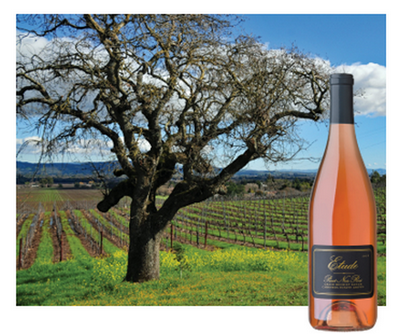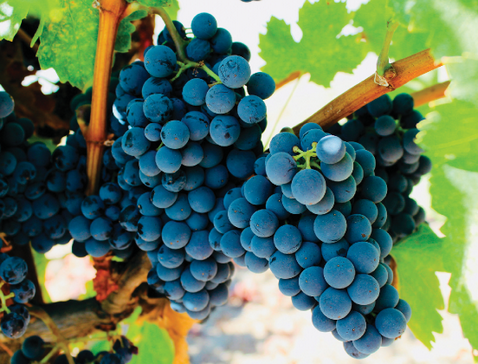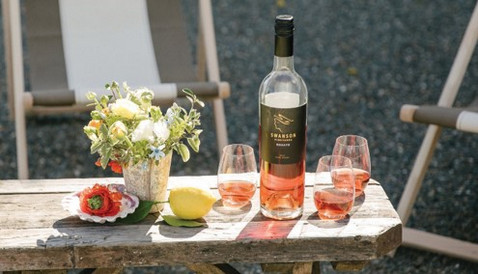Drink Pink
“Pink sunshine” and “freshness in a glass” are catchy phrases Robert Sinskey winemaker Jeff Virnig uses to describe the winery’s latest release of the 2020 Vin Gris of Pinot Noir, a complex pink wine with bright, fruity flavors, crisp acidity, and long dry finish. With a brilliant pale salmon hue, this signature style has become the benchmark for where classy pink wines have come over the past thirty years and one of the many reasons wine lovers flock to Napa Valley in the springtime to get their hands on these energetic young wines before they sell out.
The road to rosé’s popularity in Napa Valley did not happen overnight.
When Virnig started making rosé in1991, his goal was to create a fun, quaffable, food-friendly wine that added instant excitement to gatherings any time it was served. But at the time, the impression pink wines were making on American consumers was swayed by the sugary imports like Mateus and Lancers, which flooded the marketplace in the late 1960s. When Sutter Home Family Vineyards winemaker Bob Trinchero released their White Zinfandel in 1975, people went crazy for it, but it was still snubbed by serious wine drinkers.
As a result, the first few vintages of the Robert Sinskey Vin Gris were sold to wine buyers and sommeliers in New York City, who catered to world travelers that were already familiar with the drier styles of rosé produced in France, Italy, Spain and German. As the years passed, this learning curve gave Virnig and other adventurous winemakers of Napa Valley time to develop special techniques now being used to create various expressions of rosé wines.

Making rosé wine is more complex than one may think. It requires knowledge of both red and white winemaking components. Depending on the intended outcome, winemakers employ several different maceration techniques which revolve around the amount of time the juice is exposed to the skin. Whether they bleed off the juice using a process called saignée or use a direct press method with minimal skin contact, each technique creates a different style of rosé resulting in various color hues, levels of acidity, and flavor profiles.

Carneros’s Saintsbury Winery was an early producer of rosé, crafting their first release of the Vincent Vin Gris with extra fruit from the 1989 vintage. Today, winemaker Tim Colla picks the grapes at a low sugar level around 22-Brix. He uses a slow whole cluster pressing technique to capture the fruit’s high-tone flavors and ethereal aromatic character. With classic notes of wild strawberry, guava, pithy citrus, and mineral, the wine sells out within a matter of weeks once it’s released. “When it comes to the Vin Gris, our club members buy by the case, not the bottle,” said Colla.
Another success story is the Etude Rosé of Pinot Noir, which is made exclusively with fruit grown at the top of the Grace Benoit Ranch, a dynamic hillside property located on the far western edge of the Carneros appellation. Head winemaker Jon Priest, who joined the team in 2005, refers to this high-elevation portion of the site as the Siberian Vineyard because of its unique combination of chilly maritime winds and dense soils.
“For us, the focus is centered on matching the tart and tangy flavors with the natural verve that is always there to create an elegant wine that is fresh, crisp, and leaves you with a mouth-puckering dry finish,” said Priest.
THE ROSÉ REVOLUTION MOVES NORTH
As pink wine programs focused on Pinot Noir grapes hit stride at the turn of the millennium, a new wave of European-style wines designed to stimulate, delight, and refresh the palate began to gain traction in the warmer areas of Napa Valley. Today, these young, bright, and thirst-quenching wines are made with a wide range of red grape varieties, such as Grenache, Syrah, and Cabernet Sauvignon, which are deliberately picked early and quickly separated from the skins to capture the fresh, fruity flavors and keep the levels of alcohol and tannins to a minimum. In contrast to the more full-bodied red wines that require time to develop in the cellar and bottle, these spirited young wines offer instant gratification the moment they are introduced in the spring.
Although it’s becoming more challenging to find in Napa Valley, at the top of this list is the famous Italian red grape variety Sangiovese. Today it is used to make a series of beloved pink wines from Benessere Vineyards, Miner Family Winery, and Swanson Vineyards, which feature fragrant aromas, ripe flavors, and bone-dry finishes that work wonders when served at casual gatherings throughout the year.

To pay homage to the famous French winegrowing region of Provence, Julien and Élan Fayard launched their Azur Rosé d’Or’s first vintage in 2007. As the years have passed, Fayard has gained a reputation for mastery of the Provençale winemaking style, as seen in the 2,000 cases of premium rosé wines made with pristine Grenache and Syrah grapes grown in the Sierra Foothills and Rutherford’s prestigious McGah Heritage Vineyard. The McGah vineyard produces just five acres of Grenache for Fayard and a handful of boutique Napa vintners such as Kale, 601 Cellars, and Zuidema Wine Co., all with much acclaim. Grenache and Syrah instill elegance and complexity to rosé wines as found in Prêt à Boire’s annual offering, a luxurious pink wine bottled under the Amuse Bouche label started by John Schwartz and legendary winemaker Heidi Barrett in 2002.
PINK WINE DIVA: HEIDI BARRETT
On her way to becoming one of Napa Valley’s most prolific red wine specialists, Barrett developed a passion for playful wines with pink hues when she began crafting a popular dry version of White Zinfandel at Saint Helena-based Buehler Vineyards in the mid-1980s. Today, beyond Prêt à Boire’s seasonal releases and the more delicate Italian-style rosato she makes with Primitivo grapes for her private brand La Sirena, Barrett also crafts an impressive line-up of stylish pink wines for clients.
Included on this list is the Paradigm Rosé of Merlot, which offers a unique chance to taste the pure fruit flavors of this famous red grape without oak. Another is the tangy, citrus-driven Lamborn “Mary- Hana” Rosé, made with Zinfandel grapes grown at the Lamborn Family Vineyard on Howell Mountain. “To me, these fun wines represent the new Beaujolais of California,” said Barrett. “I like to call them young, fresh, ‘turn and burn’ wines that are ripe, tangy, and approachable the minute they hit the glass.”

At the higher end of the scale is Kenzo’s “Yui” Rosé, a dainty yet complex Bordeaux- style blend made with fruit from the Kenzo Estate off Monticello Road, east of Napa. In Japanese, “Yui” means unity. To Barrett, this wine’s majesty comes through with a unique blend of Cabernet Sauvignon, Merlot, and Malbec, which deliver fleshy fruit flavors of strawberry and plum with layers of spice.
Although Barrett has been making the Fantesca Cabernet Rosé on Spring Mountain since 2011, the 2020 release played an essential role in saving what would have otherwise been lost vintage due to smoke taint caused by the Glass Fire during harvest. Once the clusters were picked, the clear juice was quickly removed from the skins; fermented; and finished off with a splash of Petit Verdot to add color. The result was a charming rosé that Barrett described as “delicious and clean as a whistle.”
In the spring and summer months, serving these fantastic new styles of dry pink wine is a win-win situation for everyone involved. Not only will the wine-savvy applaud being on- trend, but novices will also appreciate the epiphany of discovering a refreshing pink wine that is dry, not sweet.
Enjoying Pink Bubbles
Until recently, it was rare to find sparkling wines with magnificent pink hues produced outside of the famous Champagne region of France. Thanks to Pinot Noir grapes’ success in the Carneros region, west of Napa, there are now great opportunities to sample world- class offerings of bubbly pink sensations.
“America’s fascination with rosé is unstoppable,” said winemaker T.J. Evans, of Domaine Carneros, who helps divide and conquer with estate-grown Pinot Noir grapes used expressly to make a limited release of the elegant still wine called “Avant Garde” Pinot Noir Rosé, as well as the four separate sparkling wine versions, including Brut Rosé, Late Disgorged Brut Rosé, Brut Rosé Cuvée de la Pompadour, and the ultra-premium Le Rêve Rosé.
“I remember thinking, ‘When is the bubble going to burst when it comes to pink wines?’ said Evans. “And now it goes on and on, which is a benefit for all of us.”
Other elegant, sophisticated, and evocative choices that fit into this category include brut rosé selections from Chandon, Schramsberg, Cuvaison, Artesa, and Mumm Napa. And besides crafting a delightful version of Brut Rosé, Frank Family Vineyards also makes “Rouge,” a brilliant crimson red offering made in the classic méthode champenoise style, which includes more skin contact time with the Pinot Noir grapes and a smaller portion of Chardonnay to add more depth and creaminess to the texture.
Article By: Chris Sawyer

